
The biggest threat to mankind may not end up being an enormous weapon; in fact, it might be too small to visualize without a microscope. Between global interconnectedness and instant travel, the age of genomic manipulation, and ever-emerging infectious disease possibilities, our biggest fears should be rooted in global health and bioterrorism. We got a recent taste of this with Stephen Soderberg’s academic, sterile 2011 film Contagion. Helix, a brilliant new sci-fi thriller from Battlestar Galactica creator Ronald D. Moore, isn’t overly concerned with whether the audience knows the difference between antivirals and a retrovirus or heavy-handed attempts at replicating laboratory experiments and epidemiology lectures. What it does do is explore infectious disease outbreak and bioterrorism in the greater context of global health and medicine in a visceral, visually chilling way. In the world of Helix, it’s not a matter of if, just when… and what we do about it after the fact. ScriptPhD.com reviews the first three episodes under the “continue reading” cut.
The benign opening scenes of Helix take place virtually every day at the Centers for Disease Control, along with global health centers all over the world. Dr. Alan Farragut, leader of a CDC outbreak team, is assembling and training a group of researchers to investigate a possible viral outbreak at a remote research called Arctic Biosystems. Tucked away in Antarctica under extreme working conditions, and completely removed from international oversight, the self-contained building employs 106 scientists from 35 countries. One of these scientists, Dr. Peter Farragut, is not only Alan’s brother but also appears to be Patient Zero.

It doesn’t take the newly assembled team long to discover that all is not as it seems at Arctic Biosystems. Deceipt and evasiveness from the staff lead to the discovery of a frightening web of animal research, uncovering the tip of an iceberg of ‘pseudoscience’ experimentation that may have led to the viral outbreak, among other dangers. The mysterious Dr. Hiroshi Hatake, the head of Ilaria Corporation, which runs the facility, may have nefarious motivations, yet is desperately reliant on the CDC researchers to contain the situation. The involvement of the US Army engineers and scientists, culminating in a shocking, devastating ending to the third episode, hints that the CDC doesn’t think the outbreak was accidental. Most frightening of all is the discovery of two separate strains of the virus, Narvic A and Narvic B, the former of which turns victims into a bag of Ebola-like hemorrhagic black sludge, while the latter rewires the brain to create superhuman strength – a perfect contagion machine.
With some pretty brilliant sci-fi minds orchestrating the series, including Moore, Lost alum Steven Maeda and Contact producer Lynda Obst, it’s not surprising that Helix extrapolates extremely accurate and salient themes facing today’s scientific environment. Spot on is the friction between communication and collaboration between the agencies depicted on the show – the CDC, bioengineers from the US Army and the fictional Arctic Biosystems research facility. In reality, identifying and curtailing emerging infectious disease outbreaks requires a network of collaboration among, chiefly, the World Health Organization, the CDC, the US Army Medical Research Institute of Infectious Diseases (USAMRIID, famously portrayed in the film Outbreak) and local medical, research and epidemiological outposts at the outbreak site(s). In addition to managing egos, agencies must quickly share proprietary data and balance global oversight (WHO) with local and federal juristictions, which can be a challenge even under ordinary conditions. To that extent, including a revised set of international health regulations in 2005 and the establishment of an official highly transimissible form of the virus created a hailstorm of controversy. In addition to a publishing moratorium of 60 days and censorship of key data, debate raged on the necessity of publishing the findings at all from a national security standpoint and the benefit to risk value of such “dual-use” research. Similar fears of “playing God” were stoked after the creation of a fully synthetic cell by J. Craig Venter and the team behind the Genome Project.

As with Moore’s other SyFy series, Battlestar Galactica, Helix is not perfect, and will need time and patience (from both the network and viewing audience) to strike the right chemistry and develop evenness in its storytelling. The dialogue feels forced at times, particularly among the lead characters and with rapid fire high-level scientific jargon, of which there is a surprising amount. Certain scenes involving the gruesomeness of the viruses feel too long and repetitive in the first episodes, but this will quickly dissipate as the plot develops. But for all of its minor blemishes, Helix is one of the smartest scientific premises to hit television in recent times, and looks to deftly explore familiar sci-fi themes of bioengineering ethics and the risks of ‘playing God’ just because we have the technology to do so.
We’ve become accustomed to sci-fi terrifying us visually, such as the ‘walker’ zombies of The Walking Dead or even psychologically, as in the recent hit movie Gravity. But Helix’s terror is drawn from the utter plausibility of the scenario it presents.
View an extended 15 minute sample of the Helix pilot here:
Helix will air on Friday nights at 10:00 PM ET/PT on SyFy channel.
~*ScriptPhD*~
*****************
ScriptPhD.com covers science and technology in entertainment, media and advertising. Hire us for creative content development.
Subscribe to free email notifications of new posts on our home page.
]]>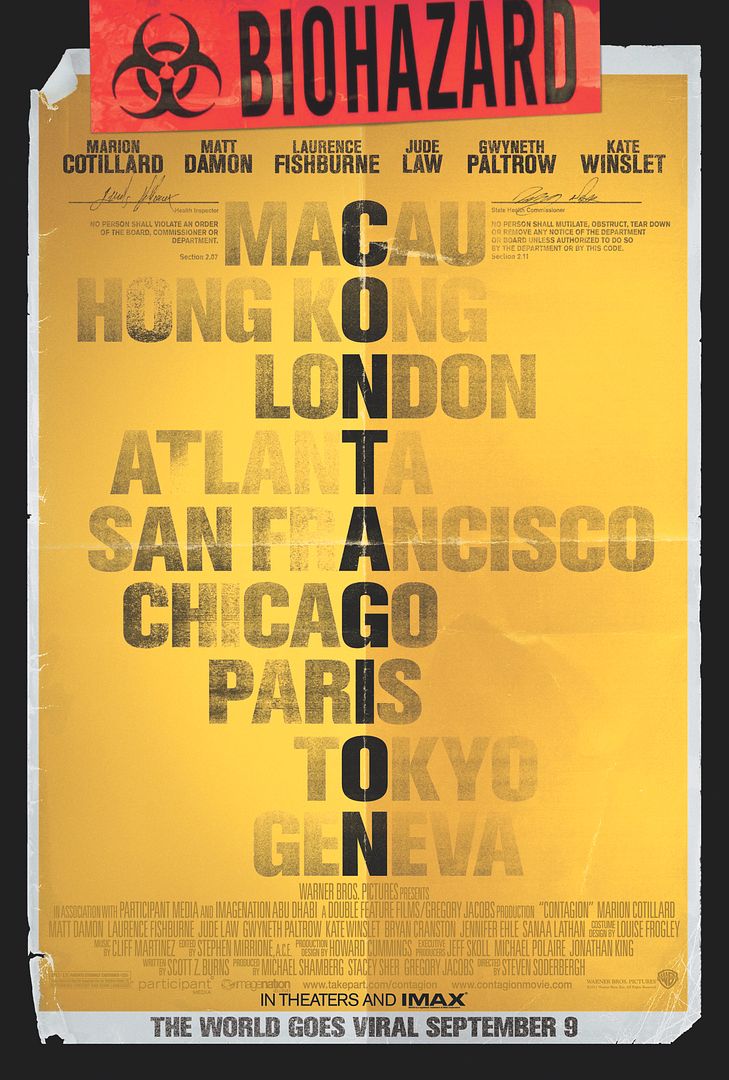
“Don’t talk to anyone, don’t touch anyone.” The austere slogan of the new film Contagion mirrors the gripping subject matter of the latest addition to the pandemic disaster movie club. One of the most science-oriented films to be released in the last few years, Contagion follows the path of several scientists, public health workers, and ordinary citizens as a full-fledged pandemic breaks out from an unknown virus. It explores scientific, moral, social and ethical questions for how we would prepare as a modern society if such a tragedy ever struck us. Additionally, Contagion is a cinematic ode to the visual and technical wonders of modern science, on full display here, both in the storyline and the beatifully-designed sets and costumes. For a full ScriptPhD review, including information on the behind-the-scenes science consultants that worked with the film’s producers to create scientific realism, click “continue reading” below.
REVIEW: Contagion
ScriptPhD Grade: B-
Contagion is one of those all-star Hollywood packages that seem too good to be true, and in this case it is. It’s clear that Oscar-winning director Steven Soderbergh (Erin Brokovich, Traffic, Ocean’s Eleven) paid attention to his advisors and took the time to get the science right, but perhaps he did so at the cost of any real drama making its way through the movie. The star-studded cast, which includes Matt Damon, Kate Winslet, Marion Cotillard, Gwyneth Paltrow, Jude Law and Lawrence Fishburne, may have delivered great performances in their original storylines, but the final cut is such an odd mash up of actionless sequences that it’s impossible to stay invested in any of their stories.

When Beth Ernhoff (Gwyneth Paltrow) returns home to Minneapolis, her bad case of let lag takes a perilous turn for the worse, and two days later, she is dead. To the shock and dismay of her grieving husband Thomas (Matt Damon), doctors don’t know the cause. Soon, the contagion spreads around our increasingly interconnected world, and a pandemic ensues. Scientists at the United States Centers for Disease Control soon take on deciphering the code of a rapidly mutating virus along with quelling the simultaneously rising tide of public panic. While Deputy Director Ellis Cheever (Laurence Fishbourne) allays public panic, Dr. Erin Mears (Kate Winslet) is sent directly into harm’s way. Concurrently, WHO Dr. Leona Orantes (Marion Cotillard) delegates solving the maze of clues that will eventually lead back to what ordinated the virus. While the doctors race time to find a cure, their efforts are thwarted by extremist activist blogger Alan Krumwiede (Jude Law), whose conspiracy theories that the public isn’t getting the whole story from the US Government, which sets of a wave of paranoia more dangerous than the virus itself.
Scientists rejoice! As a realistic depiction of a bird flu epidemic, Contagion attempts to right some of the scientific wrongs of Outbreak, which played more like a conventional zombie movie than a warning parable about the global reach of modern infectious diseases. Contagion was a difficult review for ScriptPhD to compose, because we’ve always marveled at the overt inaccuracies of its predecessor: an unauthorized person walking out of a secured government lab with a sample of a deadly virus (without gloves no less!), scientists and civilians walking into a Biosafety Level 4 lab without proper personal protective equipment, an unrealistic rate of viral spread, and we could go on and on…
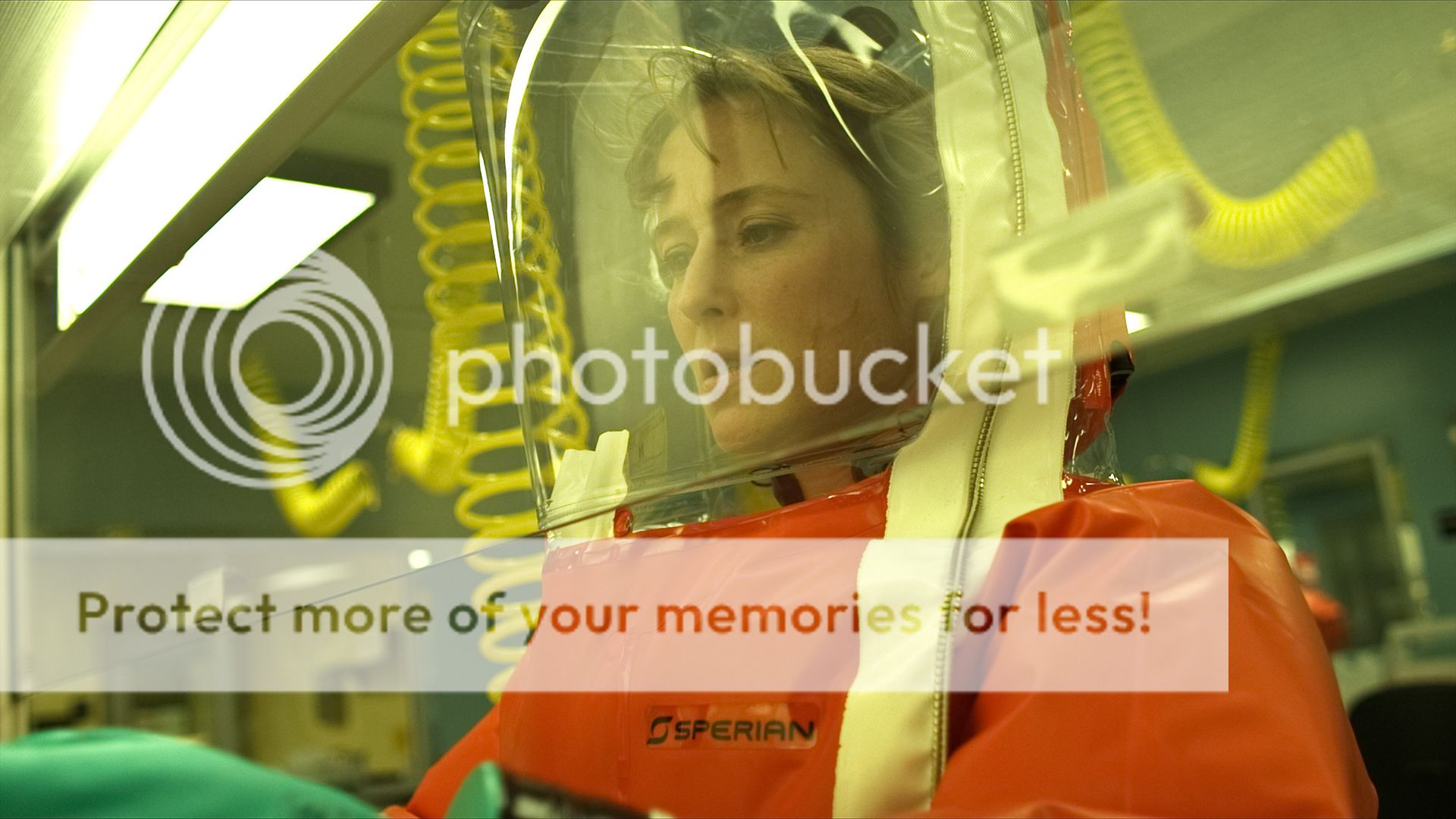
Thanks to the involvement of Participant Media and Warner Brothers, Contagion is a science film masquerading as a public service announcement to raise awareness about the possibility of such an outbreak and show that widespread panic is more dangerous than the virus itself. We applaud this goal. But too many minutes were invested in forcing actors to deliver technical language, along with clunky lines explaining their meaning. The balance between scientific accuracy and storytelling always has to ultimately tip in the balance of storytelling—the lynchpin of compelling films across all genres.
Showing scientists in realistic settings is noble and important, but lab work doesn’t qualify as action, and unfortunately for the viewing audience, that’s as good as it gets for this ‘action-thriller.’ As an example, Marion Cotillard’s Dr. Orantes is introduced in a tense moment of the film with a minute-long montage where we watch her take meetings—she’s literally sitting across a desk and talking to people—but we don’t get to hear what she’s saying because the awkward and uneven score plays over it. This is about the most boring visual montage I’ve ever seen in a movie. Then she gets thrown in a van and we don’t see her for another hour.
There’s a dark secret at the heart of how the virus afflicts Beth Ernhoff, but that drama isn’t allowed to play out in any meaningful way because there are five other plotlines to keep track of. Matt Damon gives some great scenes dealing with her death. But too many emotional punches were pulled: he skips over the death of his son to focus on somewhat-comically keeping his daughter locked away from the boy next door.

Fishburne and Winslet go a good job introducing the audience to the Center for Disease Control and the ridiculous pressures applied to government officials in their position, but don’t look for any happy endings in a movie this insistent on accurate depiction. Finally, Soderbergh is attempting to outdo himself in terms of the number of plotlines he can weave into a cohesive story, following up on his best director Oscar nod for Traffic. Where Traffic succeeded in integrating pieces into a cohesive whole, Contagion stretched my emotional attention span too thin. As the non-linear plot skips among all these amazing actors, the audience is constantly having to recall who they are and what they want.
This became comical at the wrong moment when the film returned to Cotillard’s character teaching schoolchildren in some Chinese village where she’s been held hostage. We are supposed to feel bad for these villagers, now that Marion has become one of them. But the theater was filled with a wave of frenzied whispers as entertainment bloggers consulted their neighbors on what she was doing there in the first place.
Speaking of writers and bloggers, Jude Law’s self-promoting freelancer Alan Krumwiede drew plenty of inside chuckles from the press screening crowd as a blogger seeking to profit from conspiracy theories about the government’s ties to pharmaceutical companies. His character is clearly a tongue-in-cheek homage to biological warfare NGO Sunshine Project muckraker and blogger Edward Hammond. This feeds into the film’s public service message to encourage us to trust our government in a big disaster situation, but it runs counter to the logic of movies that the little guy is corrupt and The Man is actually watching out for us.
If you’re interested in the subject matter or are fascinated by portrayal of science in film, Contagion is well worth the ticket price, but otherwise you’ll probably see it on Netflix in about three months. Contagion is hands-down the most realistic epidemic movie we’ve ever seen, but the film’s competing interests kept it from succeeding in any of its other lofty ambitions. Ultimately, it just wasn’t contagious enough.
Official Trailer:
Contagion goes into wide release on September 9, 2011 in theaters nationwide.
Natasha K. Griffith, MS, director of biosafety and biocontainment at the University of California at Los Angeles, and a world-renowned expert in training scientists to handle the most dangerous pathogens, consulted on all of the laboratory set design and high-tech suits that the actors wore during the filming. We had the opportunity to ask her a few questions about her work with Contagion.
ScriptPhD.com: Tell us a little bit about your expertise and specialty.
Natasha Griffith, MS: My expertise is in high containment laboratory design and management, primarily for Biosafety Level 3 and Biosafety Level 4 labs.
SPhD: Excellent. What kind of work, specifically, did you do for the film production crew? What were you asked to contribute?
NG: I was hired as a technical biosafety consultant. I helped with set design, that is making sure that the set was designed according to regulations, and to make sure that it matched actual BSL-3 and BSL-4 labs. Both are presented in the movie. I worked with the actors that were wearing containment suits at Level 4, and made sure that they knew what they were doing and felt comfortable in the suits. It can be a little difficult if you’ve never worn one of the suits before to just stick you into one and expect you to know what to do. I also oversaw the script, and made sure that all written lines were technically correct, and worked with the set designer to design the Level 3 and Level 4 suits. We also worked closely with the props department to make sure that the items used in the laboratory scenes and that the actors were working with were accurate research-wise. Before the filming even took place, I worked with the set and production designers to make sure that the labs were set up correctly and in place, including all the appropriate biosafety signs, and items in the freezers, and so on.
SPhD: Can you explain to people who are going to see the movie what the difference is between a Level 4 and a Level 3 lab?
NG: A Level 4 lab is truly what we call a “suit lab,” which is where the majority of this movie is presented. People are working in fully enclosed suits, so there’s no contact with the laboratory environment at all. All the air is provided through an external air line into the suit, so that people are not breathing in any air from the lab that might be contaminated with the agent they’re working with. It’s the highest possible level of containment that houses new agents, agents that have a very high mortality, and those that we don’t know much about or have a cure for. A Level 3 lab is one step down from Level 4, so there are different types of personal protective equipment that are used. In this case, the suits are not actually completely isolated from the laboratory environment, but the suits do filter the laboratory air through a special HEPA filter and eliminate any contaminants the scientist might have been exposed to. The agensts housed in a Level 3 lab are usually airborne [infectious disease agents], but we usually have some type of cure or treatment for them.
SPhD: Were there any moments during the filming of Contagion where you saw something terribly inaccurate being filmed and had to correct it? Can you give us examples?
NG: There were some details like this, but for the most part, the people I worked with were trying their best to be very accurate. Changing things wasn’t usually a big problem. A bigger challenge was explaining the highly technical information in such a way that the crew and actors could all understand what was going on and why certain things were important or something had to look a certain way. Usually, once we agreed on those big picture things, changing other small lab-specific details wasn’t a big problem.
SPhD: There have been a host of “pandemic” films that have come out in the last 10-15 years, dealing with global-scale pandemics, something really scary happening. And the fact is, we live in a global world, where in one day, you can travel across half the world (as is depicted in Contagion). The amount of stuff we touch in a given day is truly scary, which is another point the film touches on. In your opinion, having worked in this field, and all the things you’ve seen, is this storyline a Hollywood fantasy or something we should genuinely be investing our research money in and preparing for?
NG: Well, there’s always the possibility of a pandemic, and as you mentioned before, you truly can travel from one end of the world to the other in a very short period of time. So, anything that is new and emerging in Africa or Asia could be here tomorrow, so the risk definitely exists. Research money is obviously being invested already into preparedness, which is really the best way to prepare for such an event. I would say it’s definitely not a Hollywood fantasy. It is something that could happen, and something that we should keep in mind, but not something that we should be paranoid about. We have a lot of things that are always happening, and most of them don’t result in a huge pandemic. But you could say that one day, it might happen. One thing that really impressed me about Contagion was that they really, really tried hard to stay true to the science and what would happen if a pandemic actually happened.
The filmmakers of Contagion also consulted with Dr. Ian Lipkin, one of the world’s foremost microbe hunters and a professor at Columbia University’s Mailman School of Public Health. In addition to suggesting the movie’s plot might be triggered by an outbreak of a virus similar to Nipah, a deadly virus that has, on occasion, migrated from animals to people, Dr. Lipkin provided recollection of his work with the SARS epidemic in Beijing for the WHO and coached Contagion actors on the practices and procedures of scientific research. Here is a video of Dr. Lipkin discussing his work on the film, and why its broader message is so important for raising pandemic awareness and inspiring the next generation of science researchers:
~*Stephen Compson*~
************************
ScriptPhD.com covers science and technology in entertainment, media and advertising. Hire our consulting company for creative content development.
Subscribe to free email notifications of new posts on our home page.
]]>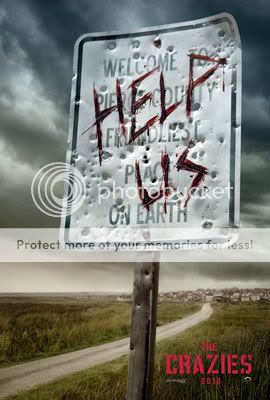
Esteemed drive-in movie critic Joe Bob Briggs has a single three-word critique of a certain kind of genre picture: “too much plot.” That’s a little easy and dismissive, but it does speak to an underlying truth: the best horror and suspense movies have to be easy to follow, or you’re in trouble. This particular genre is all about being In The Moment, especially if The Moment is designed to scare the heck out of the audience. Forcing them to pause and say, “Hey, wait a minute: why’s he doing that? Who’s that guy again? Why is he doing that?” rips the viewer out of that Moment. A better formula is to keep it simple. Or even better: keep it relentless. Out in theaters today is the well-made, competent, if flawed, bio-horror thriller The Crazies. Ironically enough, while The Crazies has some not-so-crazy plot and technical problems, the biology and science of this movie (with some minor exceptions) are the most enjoyable part. ScriptPhD.com full review and discussion under the “continue reading” cut.
Review: The Crazies
ScriptPhD Grade: B-
The Crazies, Brent Eisner’s (Sahara) from-the-bottom-up remake of George Romero’s little-seen 1973 horror flick, definitely has one driving problem: way too much plot and too much confusion for what should be a pretty straightforward story—a government toxin (or virus? or… something bad) is accidentally released in a small Ohio town. Exposure to it makes one go gradually, violently insane. And once a few random act of violence have been perpetrated on the small-town citizenry, the U.S. Government, at its most sinister, sweeps into town to round everybody up – the healthy, the diseased, and the might-be-either-ones. Town Sherriff David Dutton (Timothy Olyphant) and his local doctor wife Judy (Radha Mitchell) must fight off the infected Crazies, who look more and more like your standard Romero zombie the more their infection progresses, while trying to avoid the equally dangerous U.S. troops in their creepy gas masks, who will just as soon kill or imprison you than look into your red, rheumy eyes. Unfortunately, it’s not that simple. The story is rife with convenient but inexplicable leaps in logic, inconsistent plot points, and an erratic pacing that goes from truly Romero-esque bang-bang chomp-chomp to very long, very slow sneaky-weaky jump-out-of-the-shadow moments that, quite frankly, we’ve seen a million times before.

The best aspect of The Crazies are the actors themselves. Timothy Olyphant of Deadwood (and a new ABC TV series, Justitifed) is the quintessential strong but silent good guy, just like he’s been before and will be again. Radha Mitchell, the Australian actress best known for Pitch Black, is sympathetic without being weak or stupid. And British actor Joseph Anderson, who’s met with unfortunate quasi-supernatural fates before in Control and The Ruins, doesn’t fare much better here as Olyphant’s deputy. In fact, he has the toughest character arc of all, going from charming good ol’ boy to prick to hero in the space of ninety minutes (and with a lot of time off screen). While ensconced in a shaky plot, the film manages to get most of the science, particularly the biosafety pandemic protocols, reasonably correct given the limitations. The production values are exceptionally high as well, and there are a few “keeper” sequences that will please horror fans regardless of the total package. Expect to hear folks talking about the bone-saw scene, or the pitchfork scene, or the carwash scene, or the truck stop scene, all of which, taken together, comprise about fifteen minutes of the movie. But that’s a lot of waiting around for a few cool moments.
The film’s nonsensical interruptions are the only real spoilers here. From the very beginning, viewers are asking “Is this a toxin? Is it a virus?
Is it only carried in the drinking water, or is it airborne, too? If it is in something as ubiquitous as the drinking water, how come some people are affected right away, and others not at all? And what exactly does it do to you?” The first couple of victims are not enraged berserkers a la 28 Days Later, or mindless shamblers out of Romero’s Day of the Dead. The first victim looks more befuddled than insane; the second looks mildly pissed off but absolutely rational in the stalking and incinerating of his innocent family. In fact, one of the oddest things about The Crazies is that nobody seems all that crazy for the longest time, although it’s true that a movie called “The Sullens” or “The Befuddleds” probably wouldn’t attract the same crowd.
What’s more, once it becomes obvious – barely after the credits have rolled – that the U.S. Government is not only behind this but well aware of the accidental infection from before the beginning, you have to wonder what all the fuss is about. One actor, with the most thankless job in the movie, shows up late in the game to spell it all out for us. The poor guy has his car rolled, his head bloodied, and his exposition about the government’s complicity interrupted by a shot to the head all in a three-minute sequence. The culprit is a tailored biological agent; government agents know what it’s going to do to the populace, so why do they hesitate on the evacuation until things get really bad? They have total satellite camera surveillance (again, we see that in the first three minutes); why do they have such trouble finding rebellious evacuees and errant Crazies wandering around in broad daylight? In fact, if the Feds are as ruthless as they seem, why try evacuation at all? Why not initiate the Final Option first rather than last, since you’re never going to let any of the uninfected back into the public sector anyway – this is a secret infection. And since when was the U.S. Army so inept that it couldn’t throw a decent perimeter around a tiny Ohio town of 1,200 – one sitting out in the open plains no less – without holes big enough for an eighteen wheeler to drive through – literally, an eighteen-wheeler.

For all its faults, The Crazies actually gets most of its science right, in a delightful surprise to ScriptPhD.com. A biological agent spreading through a local water supply would most likely have a relatively quick onset, as is seen in the film, but would also affect far more of the population than is shown on-screen, most likely for entertainment purposes. Patient populations exposed to an engineered biological virus would be screened for a high fever if not showing other symptoms, a detail the film executed correctly. However, as in The Andromeda Strain, the proposition that this virus would somehow go airborne in a short period of time, or ever, is at best unlikely scientifically. Quarantining and social distancing at the spread of a potential pandemic is indeed one of the first and most recommended guidelines. Furthermore, it is impressive that health workers and government agents are equipped with Level A biosuits, a detail missed in the horrifically inaccurate Outbreak, where civilians are allowed to wander into and out of a biosafety level 3 laboratory without them. However, the panic and brutality shown to the civilian populance was played up for dramatic effect.
Eisner, who showed just how ham-handed he can be with action pictures in Sahara, does pretty much the same thing for horror movies with The Crazies. He isn’t content to pull out every one of these well-worn horror-movie tropes a single time; we get to see them two or there or even four times each. Ever since the original Scream deconstructed the horror movie, we should know better. Something new, please, along wih the something old and something borrowed. It could be worse – far worse. There are just way too many been-there-done-that’s and way too many questions for what should be an easy, straightforward slice of quasi-zombiesque Theater of the Paranoid pic. That doesn’t make The Crazies bad; it just makes it… not too bad.
Trailer:
Brad Munson is a Los Angeles-based writer, editor, marketing coach, and advertising creative content developer. He is the author of The Mad Throne, Inside Men In Black II, and Rain. He is also the Editor-in-Chief of the fantasy, sci-fi, horror website All About The Rush.com.
~*Brad Munson*~
******************
ScriptPhD.com covers science and technology in entertainment, media and advertising. Hire our consulting company for creative content development.
Follow us on Twitter and our Facebook fan page. Subscribe to free email notifications of new posts on our home page.
]]>
We are in the midst of a pandemic, folks. A pandemic of fear. A truly formidable novel strain of influenza (H1N1) is spreading worldwide, creating an above-average spike in seasonal illness, the genuine possibility of a global influenza pandemic, and an alarmed public bombarded with opposing facts and mixed messages. It’s understandable that all of this has left people confused, scared and unsure of how to proceed. ScriptPhD.com cuts through the fray to provide a compact, easy-to-understand discussion of the science behind influenza as well as invaluable public health resources for addressing additional questions and concerns. Our discussion includes the role of media and advertising in not only informing the public responsibly, but effecting behavioral change that can save lives. Our full article, under the “continue reading” jump.
The Biology of How Flu Works
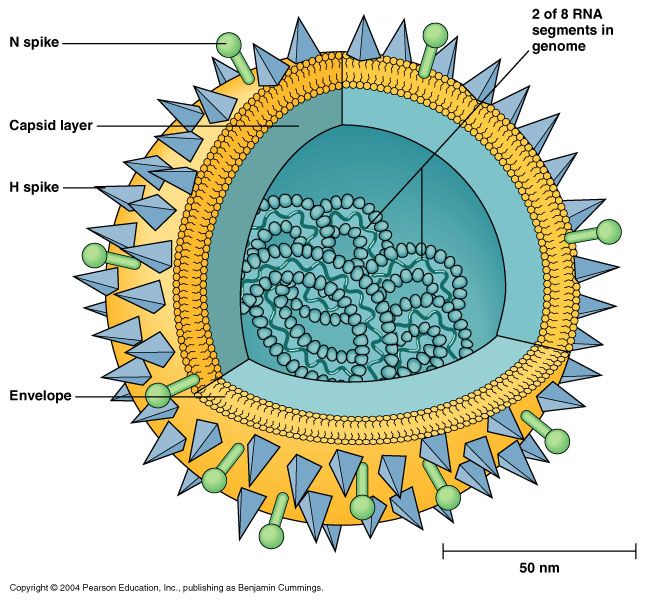
Before embarking on a long-winded discussion of flu, the H1N1 strain, vaccines, and media responsibility in the post-internet age, it’s best to start with some rudimentary facts about exactly what the influenza virus is and how it invades and replicates in the human body. While the human genome consists of a whopping 23,000 genes, the influenza virus is relatively simple. Only 8 genes, responsible for creating 11 unique proteins of the influenza genome, can ruin your whole winter. Of those 8, the most important two are the blue H spike (Hemagglutinin or HA) and the green N spike (Neuraminidase or NA). When people refer to strains of flu, such as H1N1, H2N1, H5N1, they are talking about the different genetic “mixes and matches” of the available subtypes of HA, of which there are currently 16, and NA, of which there are 9 to date. Luckily for humans, only small permutations of these end up posing a danger to our healths: the first three hemagglutinins (H1, H2, and H3) and selective neuraminidases (N1 and N2 in pandemics and N3 and N7 in isolated deaths) are found in human influenzas. Predicting future deadly combinations of the HA and NA enzymes with a degree of certainty presents an enormous challenge to biologists.
Think of the H spike and N spike as the Bonnie and Clyde of influenza infection—they have to work together to pull off the heist. The H spike finds special receptors on the surface of cells that contain an organic molecule called sialic acid, which it then sticks to and uses to form a chemical bond between the virus and the cell, like a lock going into a key. But as long as the blue H spikes are clutching to the cell’s surface, the virus is immobile. So the N spike comes along and cleaves the sialic acid chemical bond, the virus is free to make itself at home and you are one sick camper. The two current influenza drugs on the market Relenza and Tamiflu act as inhibitors, or blockers, of the NA enzyme.
In what is the best visual representation I have ever seen of how flu invades and replicates in the body, NPR teamed up with medical animator David Bolinsky to explain how one lone virus copy turns into millions by using your body’s own DNA machinery.
Seasonal Flu vs. Pandemics, A Big Difference

Each year, approximately 250,000 to 500,000 people die worldwide of influenza (36,000 in the United States). This “seasonal flu”, an infection of the respiratory tract, primarily kills high-risk populations—older people, children, pregnant women and immunocompromized patients. Seasonal flu epidemics are caused by the circulation of a group of viruses, primarily Type A, that have already presented in the human population and for which we have developed vaccines and built-up immunity. A flu pandemic requires the introduction of a new type of virus for which we have not developed innate immunity under the following conditions:
•presence of a brand new virus subtype in the human population (usually mutated from an animal form of influenza)
•the virus is capable of causing serious illness in humans (something H5N1 bird flu, for example, is not yet able to do)
•the virus can spread easily from person to person
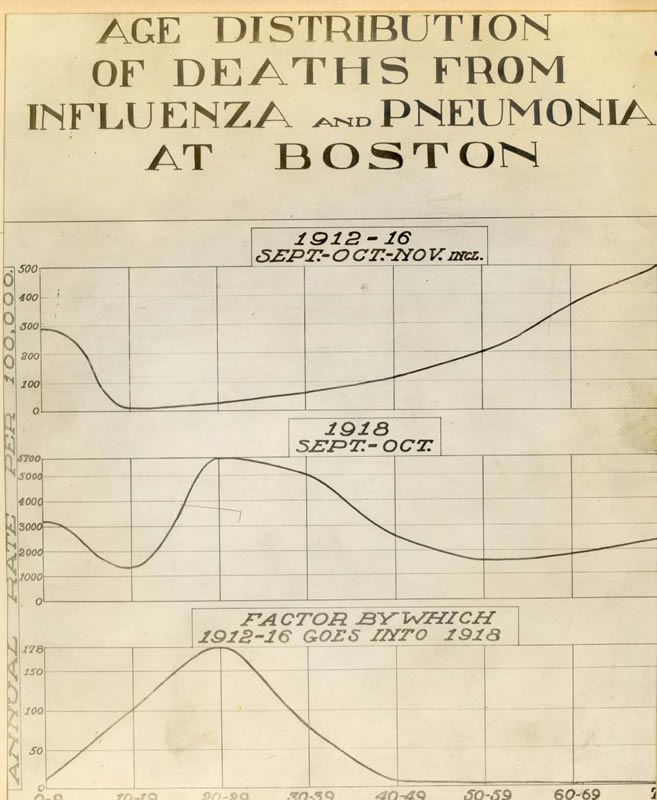
There have been three major post-industrial pandemics: the 1957 Asian flu, the 1968 Hong Kong flu and of course, the 1918 Spanish flu. The 1918 pandemic, one of the worst public health disasters of all time, killed 50 million people worldwide (a conservative estimate) at a time when the global population was only 2 billion—yes, 2.5% of the world’s population. It is said to have killed more people than the Black Plauge and the AIDS epidemic. Besides the three provisions discussed above, there is one major difference between pandemics and yearly epidemics: how they kill. The graph on the right, containing preserved data from 1918 shows two different death curves, one from regular epidemics in and around the Spanish Flu, and another from the Spanish Flu itself. Normally, yearly flu primarily kills the extremely young and extremely old, what epidemiologists call a “U-shaped curve”. Pandemics such as the 1918 flu kill primarily healthy young people, resulting in a “W-shaped curve”. World Bank economist Milan Brahmbhatt estimated that the economic toll of a similar pandemic, due to the loss of such a chunk of the healthy work force, would be approximately 2% of the world’s GDP.
So why all the fuss about H1N1 swine flu, and is it warranted? From a public health epidemiology standpoint… yes. Biological mapping and sequencing has revealed the H1N1 virus to be a novel mutation that has not circulated in human populations before this year. It has also fulfilled all of the requirements to be classified as a pandemic. On June 11th, Dr. Margaret Chan, Director-General of the World Health Organization declared H1N1 at the start of a worldwide flu pandemic. Just a week ago, President Obama declared a state of emergency in the United States to help mitigate the spread of H1N1. To date, it has killed approximately 6,000 people worldwide, with the European Centre for Disease Prevention and Control estimating an 11% increase in deaths just this week. While it is not a preordained certainty that H1N1 will absolutely result in a global pandemic carrying a similar degree of severity to any of the three from the 20th Century, it has enough disconcerting characteristics and pandemic potential to validate scientists’ calls for preventive measures, including vaccination and anti-viral stockpiles. For a terrific rundown and rebuttal of some common swine flu myths, I recommend this New Scientist article.
I also feel the need to address controversy surrounding the H1N1 vaccine, which has been both unduly vilified in the general population and improperly explained by the general media (a subject we’ll delve into in a moment). Fewer than half of Americans say they are planning on getting the H1N1 vaccine for a multitude of reasons, not the least of which include complacency about the virus potency and fear of side effects from the vaccine. While we have strived to address questions about the H1N1 virus above, I cannot state this more strongly or definitively: the vaccine developed for H1N1 is not being manufactured any differently than seasonal vaccines. It has the same ingredients, safety profile, and side effects (rare). The official flu site of the U.S. Government provides an excellent overview of vaccine safety and ingredients as well as a link for common questions and answers.
How Smart Media and Advertising Could Save Lives

The idea of advertising and marketing as tools to combat public health crises is certainly nothing new. As early as the 1860s, and peaking during the two World Wars, clever taglines married beautiful artwork to combat everything from venereal disease to tuberculosis, and they worked. Now a permanent collection of 20th-century health posters at the National Library of Medicine, these compelling, cheeky visual messages changed soldiers’ sexual habits abroad, cultural norms around communicable diseases, and widespread awareness of rising epidemics. Those campaigns were, of course, launched during a less cluttered technological era, but sometimes, simple, smart advertising can be the most effective.
Especially in today’s age of multitudinous multi-functional multimedia, more information can just mean… more information. A recent study from the World Bank addressed why we don’t do much about climate change despite the plethora of data that conclusively deduces we must. The reasoning? An influx of too much information and not enough targeting of individual behaviors. And make no mistake that advertising has an enormous subconscious influence on our behavior. A seminal paper out of the Yale University Psychology Department earlier this year showed external cues from television advertising increased food consumption 45% in children and adults irrespective of hunger. There is no reason that such enormous influence can’t and shouldn’t be harnessed in eliciting positive behavioral changes during the 2009-2010 flu season (and beyond).

The media in particular, with their highly sensationalized mood swing swine flu coverage, has played an enormously irresponsible role in fanning the fires of public fear and misinformation. Remember the desolate empty streets of Mexico City? Or the U.S. pre-emptively declaring a public health emergency? Quarantines, social distancing, vaccine and Tamiflu stockpiles, dire expert warnings, surely, impending doom was imminent. And when it wasn’t, the Great Swine Flu Scare of spring turned into a Great Swine Flu Joke of the summer— literally. Social media satire included Facebook and Twitter pages seemingly run by the swine flu itself and a hilarious interview with the Los Angeles Times. The humor underscored a more serious swine flu fatigue incurred by intense media saturation, often missing key scientific information or balanced reporting. In its analysis of swine flu accuracy in the media, the Columbia Journalism Review recently lambasted the ubiquitous hype, and the cognitive dissonance between fact and fiction in reporting by “respected” journalism outlets.
Worse than these confusing messages is the tapestry of opinions masquerading as fact about a subject buoyed by plenty of sound science and research. The most egregious offender of late was Bill Maher, who used his show as a bully pulpit to decry immunization with the H1N1 vaccine, and the severity of H1N1 itself, in an interview so fraught with misguided medicine and unsound reasoning (the majority of which we’ve addressed above) that it pains me to give it publicity on my site. The video is worth a view if only for the rebuttals of a more rational Bill, former Senate majority leader Dr. Frist.
The use of advertising as a viral public health campaign is a double edged sword. Back in 1976, an earlier wave of swine flu fear gripped the nation. Like the 2009 strain, it was unseen in the general population since the 1918 flu, and touched off a similar wave of national panic about whether a widespread plague threatened the entire United States. In what has argued as both public health’s finest hour and the swine flu “fiasco”, President Gerald Ford decided all 220 million Americans had to be immunized, and ordered hasty production of an untested vaccine that killed over 500 Americans and was ultimately halted as unsafe. Part of the government propaganda to encourage vaccination included the two frightening television commercials below.
As detailed in Arthur M. Silverstein’s book “Pure Politics and Impure Science” (a good summary can be found here), the aftermath and deleterious impact on trust in the public health infrastructure was multi-generational and devastating, perhaps even emanating in the skepticism towards the 2009 vaccine, despite entirely different safety guidelines and circumstances. A smarter approach to engaging the public is a current BBC television spot done in concert with the British Government:
This is such an excellent piece on multiple fronts. The tagline—catch it, bin it, kill it—effectively communicates sound hygiene and advocates hand washing, still by far the most potent way to ward off germs and prevent illness. It’s sleek, clever, funny, and most importantly, gross! I washed my hands after just viewing it. In conjunction with print ads, billboards and yes, old-fashioned posters, similar public service announcements should be placed during the most popular primetime television shows, sporting events, concerts, other public gatherings, and most importantly, as part of any in-flight boarding process.
What’s a Confused Germaphobe To Do?
Despite the circulation of conflicting information and influx of divergent opinions, there are some genuinely useful resources and recommendations for this flu season. Here’s a good start:
Get a flu shot! Immunization against influenza, both the seasonal and H1N1 strains, remains the only surefire effective defense against the viruses. One of the most solid and eloquent arguments for the flu shot that I’ve seen comes from Dr. William Marshall, an infectious diseases specialists at the Mayo Clinic:
Wash your hands! Short of getting vaccinated, there is no easier, cheaper, faster, more effective way of preventing colds and flu. In fact, the CDC estimates that 80% of all seasonal flu is spread by hand contact. However, not only do you need to wash your hands, you need to do so properly.
Eat, drink, sleep Never underestimate the role that good nutrition, plenty of water, and a good night’s rest can have to boost the immune system and help it naturally combat exposure to viruses, especially if you make the choice to abstain from the flu vaccine. Of all three, sleep is the most critical. Read this fascinating NY Science Times article from earlier this fall about a sleep study that showed a direct correlation between lack of sleep and increased likelihood of catching a cold.
Accept no imitations Yes, Virginia, people try to take advantage and scam even in a pandemic. Color yourself shocked. The government is issuing warnings about a growing list of Swine Flu scams, some of which could be deadly. Remember, only Tamiflu and Relenza are recommended as flu treatments and only your doctor can prescribe them. The FDA has also issued a comprehensive list of fraudulent H1N1 products, including air purifiers, soaps, masks and other concoctions. Before buying ANYTHING that claims to prevent or combat the flu, please refer to it.
Get technical Thanks to the wonders of modern technology, it’s easier than ever to track the flu, know how to prevent it and what to do if you get it. Flu.gov, the WebMD Focus on the Flu site, and the Centers for Disease Control flu homepage are excellent educational starting points. Google now provides a flu tracker to explore the severity of flu trends around the world. And for those of you that are, like the ScriptPhD, of the iPhone persuasion, a new iPhone application called “Outbreaks Near Me” developed at MIT, and available as a free download, provides GPS data on outbreak clusters in your neighborhood.
If you have any other tips, cool gadgetry, public health resources or web sites we should add to our list, please don’t hesitate to comment or email me.
~*ScriptPhD*~
*****************
ScriptPhD.com covers science and technology in entertainment, media and pop culture. Follow us on Twitter and our Facebook fan page. Subscribe to email alerts for new posts on our home page.

